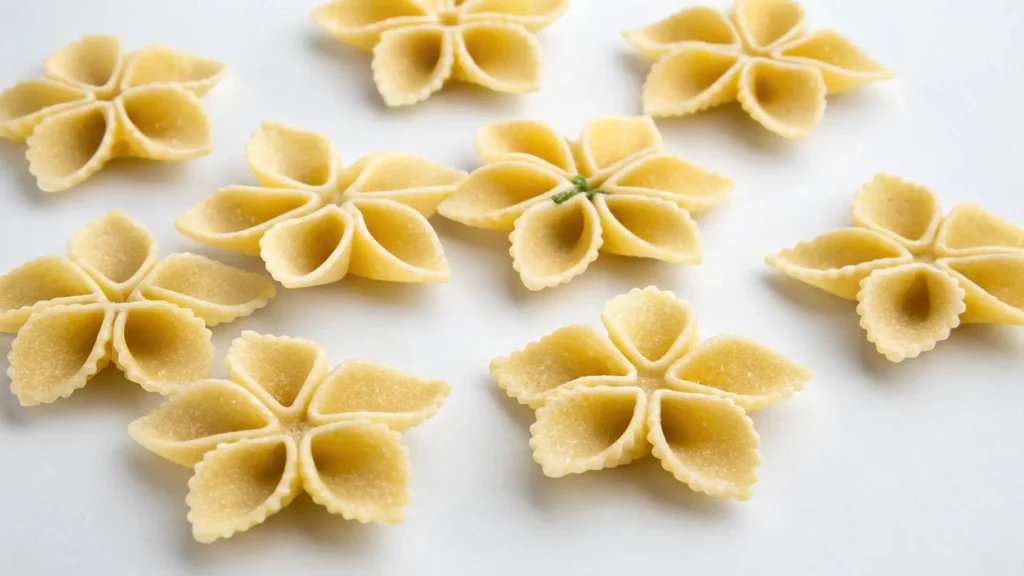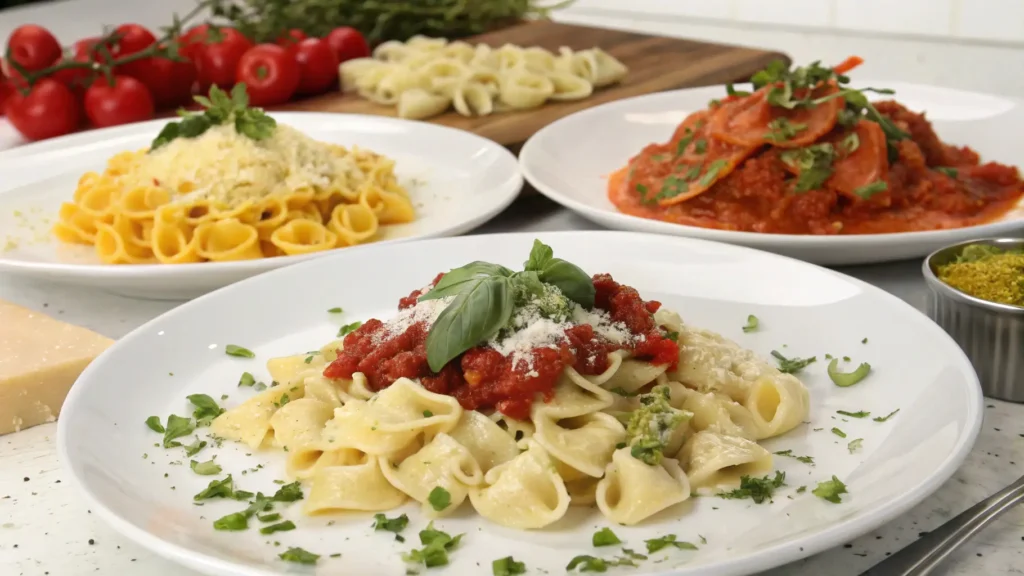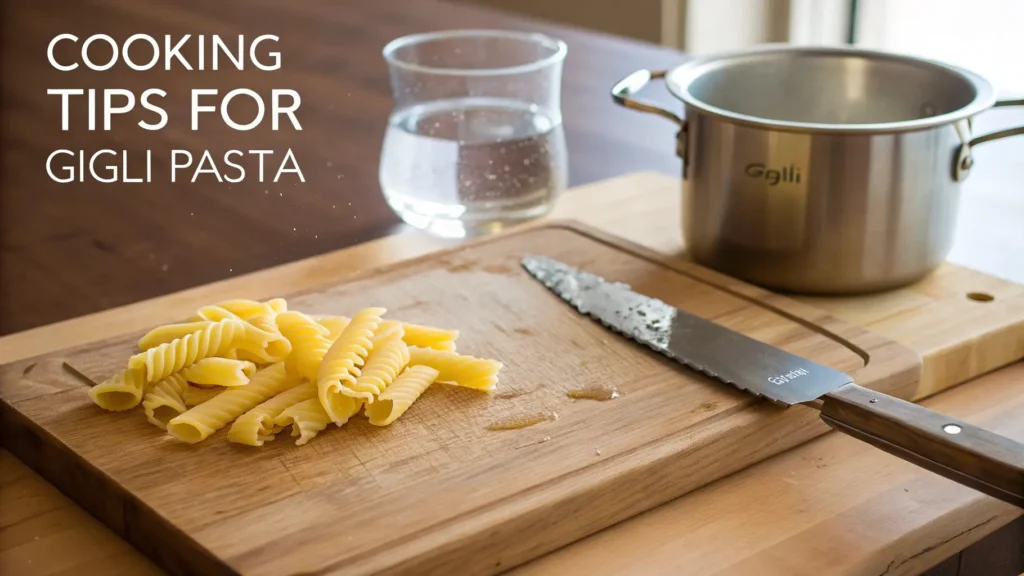Pasta comes in all shapes and sizes, each designed to complement specific flavors and textures. But have you ever asked yourself, “What kind of pasta is a gigli?” Known for its unique and beautiful design, gigli pasta stands out not just for its aesthetic appeal but also for its versatility in cooking.

In this article, we’ll uncover the origins, characteristics, and uses of gigli pasta, also known as campanelle. From its Tuscan roots to modern-day recipes, you’ll discover why this pasta deserves a place in your kitchen. We’ll also explore cooking tips, popular dishes, and substitutions, ensuring you know everything about this bell-shaped delight.
Introduction to Gigli Pasta
What is Gigli Pasta?
Gigli pasta, often called campanelle, is a short pasta shaped like a bell or flower with delicate ruffled edges. Its name, gigli, means “lily” in Italian, paying homage to Florence, where the lily is a symbolic flower. This pasta is as functional as it is beautiful, designed to hold sauces and ingredients in its folds and curves.
Unlike other short pasta, gigli adds a touch of elegance to any dish. Its unique structure not only enhances the dish’s texture but also makes it visually stunning on a plate. Gigli is a favorite in Tuscan cuisine, frequently paired with light sauces, vegetables, or creamy dressings.
Origins and Cultural Significance
Hailing from Tuscany, gigli pasta carries a rich culinary heritage. Its distinctive lily-like design is a nod to Florence’s long-standing association with the lily flower, a symbol of the city since ancient times. Historically, gigli has been a centerpiece in celebratory meals, bringing both style and substance to Italian tables.
Over time, this pasta has become a global favorite. Its versatility has made it popular not just in Italian households but also in gourmet kitchens worldwide. Whether used in traditional Tuscan recipes or modern culinary creations, gigli’s charm and functionality never go unnoticed.
Characteristics of Gigli Pasta
Shape and Structure of Gigli
If you’ve ever wondered, “What kind of pasta is a gigli?”, its shape is one of its most defining features. Gigli pasta resembles a bell or flower with gently ruffled edges. Each piece is delicate yet sturdy, making it perfect for capturing sauces and holding toppings like diced vegetables or bits of meat.
This pasta is slightly larger than some other short pastas, giving it a noticeable presence on the plate. Its flower-like design also ensures that every bite is packed with flavor. The folds and curves are especially great for creamy or chunky sauces, which cling beautifully to the surface.
How Gigli is Made
Gigli pasta is typically made using semolina flour and water, which gives it a firm texture and rich, nutty flavor. The dough is rolled and shaped into its iconic bell form, either by hand or with specialized molds. Traditional methods prioritize the pasta’s delicate ruffles, which require precision and care to create.
Modern production often involves extrusion machines, allowing gigli to be made at scale while retaining its unique structure. This ensures that even in mass production, the pasta’s aesthetic and functional qualities remain intact. Handmade gigli, however, is still considered a delicacy and is prized for its artisanal appeal.
Key Differences Between Gigli and Similar Pastas
Although gigli is often confused with campanelle, the two have slight variations. Campanelle, which means “little bells,” shares a similar flower shape but may have looser, less-defined folds compared to gigli. Both pastas are versatile, but gigli’s tighter curls make it better for holding sauces.
Other short pastas, like fusilli or penne, lack the aesthetic charm and sauce-holding capabilities of gigli. While they can be substitutes in a pinch, they don’t offer the same textural complexity or visual appeal that gigli brings to a dish.
Popular Dishes Using Gigli Pasta

Classic Italian Recipes Featuring Gigli
Gigli pasta shines in traditional Italian dishes that highlight its unique structure. One popular recipe is Gigli alla Fiorentina, where the pasta is tossed with creamy béchamel sauce, spinach, and Parmesan cheese—a dish inspired by its Tuscan roots. Another favorite is gigli served with light tomato-based sauces, complemented by fresh basil and olive oil for a simple yet flavorful meal.
In rustic Tuscan kitchens, gigli is often paired with hearty stews or meat-based ragù, allowing the pasta to soak up every bit of flavor. Its sturdy design ensures it doesn’t fall apart even in rich, slow-cooked sauces.
Modern Culinary Twists with Gigli Pasta
In contemporary cuisine, gigli has become a canvas for innovation. It’s increasingly featured in pasta salads, where its ruffled edges hold vinaigrettes and mix-ins like olives, cherry tomatoes, and mozzarella. For a fusion twist, chefs have paired gigli with ingredients like chickpeas and za’atar, blending Italian tradition with Middle Eastern flavors.
This pasta also works beautifully in baked dishes. Picture gigli layered with béchamel, cheese, and roasted vegetables, baked until golden and bubbly. Its elegant appearance makes it a great choice for dinner parties, where presentation matters just as much as taste.
Pairing Gigli with Sauces and Ingredients
The versatility of gigli lies in its ability to pair with almost any sauce or ingredient. Creamy sauces like Alfredo or cheese-based blends cling to its folds, creating a rich, indulgent bite. For a lighter option, try pesto or olive oil-based dressings, which highlight the pasta’s nutty undertones.
Vegetables, seafood, and lean proteins like chicken or turkey also complement gigli wonderfully. Whether you’re whipping up a weeknight meal or hosting a special occasion, this pasta adapts effortlessly to your culinary vision.
Substitutes for Gigli Pasta
Best Pasta Substitutes for Gigli
Sometimes, finding gigli pasta can be a challenge. When that happens, you might ask, “What kind of pasta is a gigli substitute?” Thankfully, there are plenty of options to consider.
- Campanelle: This is the closest alternative to gigli. Sharing its bell shape and ruffled edges, campanelle mimics gigli’s aesthetic and sauce-holding capabilities.
- Fusilli: Although spiral-shaped, fusilli offers a similar texture and pairs well with the same types of sauces, making it a practical option.
- Rigatoni or Penne: For baked dishes, these tubular pastas provide the sturdy structure needed to hold hearty sauces and toppings.
Choosing the right substitute depends on your recipe. For dishes that focus on presentation, campanelle is the best choice. If functionality is the priority, fusilli, rigatoni, or penne can deliver excellent results.
When and Why to Use Substitutes
You might consider substitutes for gigli pasta if it’s unavailable or if you want to experiment with slightly different textures and appearances. Substituting doesn’t mean compromising; instead, it opens doors to new culinary possibilities.
Pro tip: Adjust cooking times and sauce consistency to complement the substitute. For example, tubular pastas like rigatoni may need a thicker sauce compared to campanelle.
Cooking Tips for Gigli Pasta

How to Cook Gigli to Perfection
Perfecting gigli pasta starts with proper cooking techniques. Always use plenty of salted boiling water to avoid sticking and enhance the pasta’s natural flavor. Cook gigli until it’s al dente—firm but tender to the bite. This ensures the pasta holds its shape and sauce beautifully.
For dishes like baked gigli or casseroles, undercook the pasta by 1–2 minutes. This way, it won’t become too soft during baking. After draining, toss gigli lightly in olive oil to prevent clumping while preparing other ingredients.
Mistakes to Avoid When Cooking Gigli
- Overcooking: Gigli’s delicate ruffles can lose their structure if overboiled.
- Too Much Sauce: While gigli holds sauces well, excessive amounts can overpower the dish’s balance. Aim for just enough to coat the pasta evenly.
- Skipping the Rest: After cooking, let gigli sit briefly to absorb the flavors of your sauce. This step enhances the dish’s overall taste.
For more pasta insights, check out the ultimate guide to gigli pasta, where you’ll find tips, recipes, and serving ideas.
Frequently Asked Questions (FAQs)
What Kind of Pasta is Gigli?
If you’re curious about “What kind of pasta is a gigli?”, it’s a short, bell-shaped pasta with ruffled edges. Also known as campanelle, its name comes from the Italian word for “lily.” This pasta is uniquely designed to hold sauces and small ingredients, making it a versatile choice for both traditional and modern recipes.
What Sauces Work Best with Gigli Pasta?
Gigli pairs beautifully with a wide range of sauces. Creamy options like Alfredo or cheese-based blends cling to its folds for a rich and indulgent dish. For something lighter, a pesto or olive oil-based sauce highlights its subtle nutty flavor. Chunky tomato-based sauces and meat ragù also complement gigli, as its sturdy structure can hold up to hearty textures.
Can Gigli Be Used in Baked Dishes?
Absolutely! Gigli excels in baked dishes. Its sturdy shape and ability to trap fillings make it a great option for casseroles and pasta bakes. Layer it with béchamel sauce, cheese, and vegetables for a crowd-pleasing dish that looks as good as it tastes.
Conclusion
Wrapping Up: What Kind of Pasta is a Gigli?
By now, we’ve explored the answer to “What kind of pasta is a gigli?” and so much more. This lily-shaped pasta isn’t just visually stunning—it’s a culinary multitasker that adapts to a variety of recipes. From creamy sauces to baked delights, gigli adds both charm and function to your meals.
Final Tips for Mastering Gigli Pasta
Whether you’re trying gigli for the first time or looking for substitutes, remember these tips:
- Always cook gigli al dente to maintain its shape.
- Pair it with sauces that match its texture, like creamy or chunky blends.
- Use substitutes like campanelle or fusilli when gigli is unavailable, adjusting your sauce accordingly.
If you’re feeling inspired, explore more recipes and ideas on websites like Tangle Recipes. With a little creativity, you’ll find that gigli pasta can elevate even the simplest of dishes into something extraordinary.
So go ahead, grab a bag of gigli or its substitutes, and get cooking. Whether you’re hosting friends or making a comforting dinner for yourself, gigli pasta is sure to impress every time!
